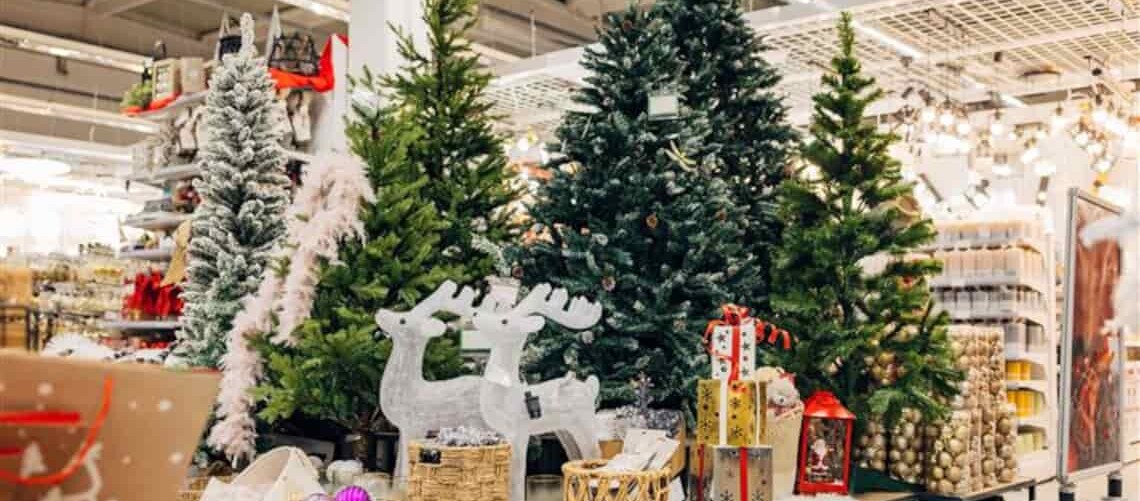Christmas Decorations, Then and Now
Traditional Christmas decorations often involved a lot of handcrafting, relying on skills passed down through generations. While those traditions are still appreciated, modern manufacturing has started using high technology like 3D printing to create unique and personalized designs.
Also, today, consumers are more aware of their environmental impact, leading to a surge in demand for eco-friendly options. Manufacturing companies are responding by embracing synthetic materials with lower environmental footprints and exploring innovative ways to utilize recycled and bio-based materials.
For instance, Christmas trees are now made from recycled plastic or reclaimed wood, very different from the traditional Christmas tree harvested from natural forests. These manufacturing products not only reduce waste but also contribute to a circular economy by giving new life to discarded materials.
How Technology is being Embedded in Christmas Traditions
The integration of technology into the very fabric of Christmas decorations is another trend. Smart decorations with interactive lighting, responsive surfaces, and embedded sensors transform decorations during the festive season. For example, ornaments that react to music or change color with a simple touch. These advancements are blurring the lines between decoration and entertainment, creating immersive experiences that capture the magic of Christmas in new and exciting ways.
Why Synthetic Materials Are Still Used in Manufacturing Decorative Items
It's true that synthetic materials, especially plastics, have a negative connotation. But the truth is they offer some unique advantages when it comes to making decorations.
The increasing use of recycled plastics in Christmas decorations aligns with the European Commission's efforts to develop 'end-of-waste' criteria for plastics. This could further incentivize the use of recycled content in decorations, boosting the market for these sustainable materials
Advancements in materials science have led to synthetic options that can look and feel just like traditional materials, but with a boost in durability and longevity. This is a game-changer, especially for outdoor decorations that need to hold up against the elements.
Beyond durability, new synthetic materials also open a world of creative possibilities. They can be molded into intricate shapes, easily customized with colors and textures, and produced affordably, making them a versatile choice for manufacturers and consumers alike.
The AI Advantage for decoration manufacturing companies
AI-powered algorithms are optimizing the design process for Christmas decorations, while machine learning enables automated production lines. It's not just about fancy algorithms; but also about tangible improvements on the factory floor. Here's how this tech is enabling manufacturers to respond to evolving consumer demands with greater agility and creativity:
- Smart Pattern Generation: AI-powered software can generate unique patterns for ornaments, textiles, and more, going beyond limitations in resources.
- Aesthetic Simulation: that enables designers to experiment with a wide range of colors and finishes in a virtual environment, fine-tuning their creations before committing to production.
- Streamlined Workflows: by analyzing data and predicting potential bottlenecks, leading to smoother production, less waste, and ultimately, cost savings.
- CNC Machining: Computer Numerical Control (CNC) machines are becoming increasingly sophisticated, using AI to automate tasks like cutting, carving, and engraving intricate details on ornaments and other decorative items. They ensure precision and consistency.
- Predictive Trendspotting: by analyzing market trends and making data-based predictions, helping companies stay ahead of the curve.
AI technology is particularly valuable for high-volume production, ensuring that manufacturing products meet the highest quality standards.

The Human Touch and Brand Values Still Matter in Holiday Decorations
While mass production dominates the market, there's a growing appreciation for the unique character of handmade and upcycled ornaments. These pieces often tell a story, reflecting cultural heritage, artisan skill, and a personal touch that mass-produced items simply can't replicate. This is where the concepts of "continuity" and "values" become essential.
Upcycling embodies continuity by giving new life to old materials. Today's upcycling scene is a mix of individual crafters, small businesses, and even larger companies embracing the concept. Old sweaters are reborn as cozy Christmas stockings, glass jars become twinkling snow globes, and wine corks transform into rustic ornaments. This modern take on upcycling often involves innovative techniques and a focus on aesthetics, creating decorations that are both sustainable and stylish.
While much of this magic happens on a small scale with individual crafters and artisans, the principles of upcycling are also being embraced by larger manufacturing companies. In fact, they are finding innovative ways to incorporate reclaimed materials into their production processes, transforming industrial waste into beautiful and functional decorations.
How Industries are Embracing the Diverse Cultural Heritage of Traditional Christmas Decorations
Christmas decorations in Europe tell a story about each country's unique traditions and skills. They show how people use local materials and old ways of making things to celebrate the holidays. These traditions are now inspiring modern manufacturers to create decorations that are both beautiful and meaningful, at a large scale.
- Scandinavian countries often opt for rustic and minimalist decorations crafted from pinecones, branches, berries, and wood.
- In Germany, the art of glassblowing has a long and rich tradition. These exquisite creations showcase the precision and artistry of German craftsmanship.
- In Poland, wood carving and paper cutting are cherished folk traditions.
- In Italy, Christmas decorations often feature the country's renowned ceramics and terracotta, showcasing the artistry of Italian artisans.
These examples serve as tangible expressions of cultural identity, showcasing traditional crafts and local materials that have been passed down through generations. As technology continues to evolve, the industry of decorations will likely thrive in the harmonious blend of innovation and tradition, where cutting-edge manufacturing techniques enhance, rather than replace, the artistry and cultural significance embedded in each festive piece.

